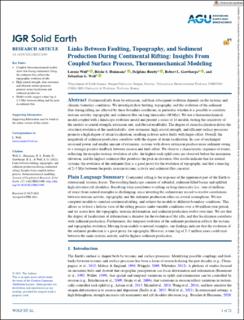| dc.contributor.author | Wolf, Lorenz | |
| dc.contributor.author | Huismans, Ritske Sipke | |
| dc.contributor.author | Rouby, Delphine | |
| dc.contributor.author | Gawthorpe, Rob | |
| dc.contributor.author | Wolf, Sebastian Georg | |
| dc.date.accessioned | 2023-02-14T13:06:46Z | |
| dc.date.available | 2023-02-14T13:06:46Z | |
| dc.date.created | 2022-05-01T13:26:34Z | |
| dc.date.issued | 2022 | |
| dc.identifier.issn | 2169-9313 | |
| dc.identifier.uri | https://hdl.handle.net/11250/3050744 | |
| dc.description.abstract | Continental rifts form by extension, and their subsequent evolution depends on the tectonic and climatic boundary conditions. We investigate how faulting, topography, and the evolution of the sediment flux during rifting are affected by these boundary conditions, in particular whether it is possible to correlate tectonic activity, topography, and sediment flux on long timescales (40 Myr). We use a thermomechanical model coupled with a landscape evolution model and present a series of 14 models, testing the sensitivity of the models to crustal strength, extension rate, and fluvial erodibility. The degree of strain localization drives the structural evolution of the modeled rifts: slow extension, high crustal strength, and efficient surface processes promote a high degree of strain localization, resulting in fewer active faults with larger offset. Overall, the magnitude of sediment production correlates with the degree of strain localization. In case of unchanged erosional power and similar amount of extension, systems with slower extension produce more sediment owing to a stronger positive feedback between erosion and fault offset. We observe a characteristic sequence of events, reflecting the morpho-tectonic evolution of rifts: the highest rock uplift rates are observed before the maximum elevation, and the highest sediment flux postdates the peak in elevation. Our results indicate that for natural systems, the evolution of the sediment flux is a good proxy for the evolution of topography, and that a time lag of 2–5 Myr between the peaks in main tectonic activity and sediment flux can exist. | en_US |
| dc.language.iso | eng | en_US |
| dc.publisher | AGU | en_US |
| dc.rights | Navngivelse 4.0 Internasjonal | * |
| dc.rights.uri | http://creativecommons.org/licenses/by/4.0/deed.no | * |
| dc.title | Links Between Faulting, Topography, and Sediment Production During Continental Rifting: Insights From Coupled Surface Process, Thermomechanical Modeling | en_US |
| dc.type | Journal article | en_US |
| dc.type | Peer reviewed | en_US |
| dc.description.version | publishedVersion | en_US |
| dc.rights.holder | Copyright 2022 The Author(s) | en_US |
| dc.source.articlenumber | e2021JB023490 | en_US |
| cristin.ispublished | true | |
| cristin.fulltext | original | |
| cristin.qualitycode | 2 | |
| dc.identifier.doi | 10.1029/2021JB023490 | |
| dc.identifier.cristin | 2020399 | |
| dc.source.journal | Journal of Geophysical Research (JGR): Solid Earth | en_US |
| dc.relation.project | Sigma2: NN4704K | en_US |
| dc.relation.project | Sigma2: NS4704K | en_US |
| dc.identifier.citation | Journal of Geophysical Research (JGR): Solid Earth. 2022, 127 (3), e2021JB023490. | en_US |
| dc.source.volume | 127 | en_US |
| dc.source.issue | 3 | en_US |

